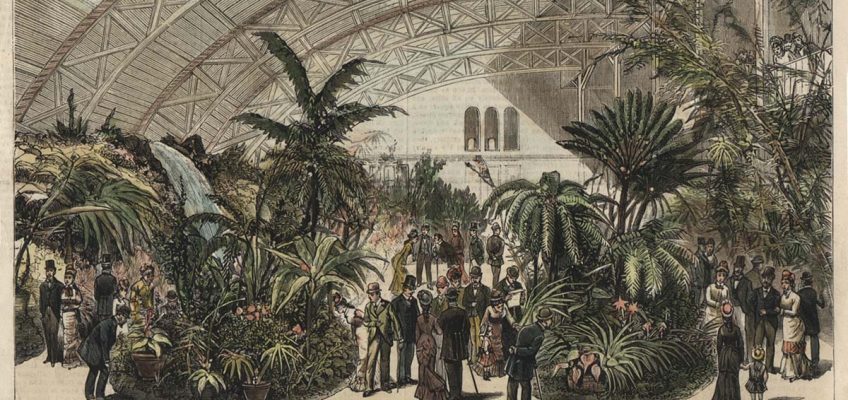I’ll not go in there agin! There’s the most infernal-lookin’ creature I ever saw!
Those words were sputtered by P. J. Hogan, a gas-fitter for the Opera Festival. In February 1882, he was in Horticultural Hall, the south wing of Music Hall. His assignment was simple: connect the street gas with the building.
He took his wrench and lantern, and went inside. To access the connector, he crawled under the raised portion of the display area.
Suddenly he bolted out. When he reached Music Hall staff member Tom Wise, he was so terrified he could hardly speak!
It opened its big jaws and wagged its baistly tail at me, and wanted to ait me up!
Tom Wise was befuddled. Horticultural Hall was a peaceful building. During the Expositions, it featured flowers and greenery. A waterfall cascaded down a huge stone structure, into a lake. A cavern behind the waterfall had been constructed.
What could Mr. Hogan be talking about?
Mr. Wise walked over and looked into the cavern, then ran out even faster than Mr. Hogan. He was there long enough to recognize the source: a hissing, moving, jaw-dropping, probably hungry and definitely annoyed – alligator.
How did an alligator get into Music Hall?
Music Hall Gets its Wings
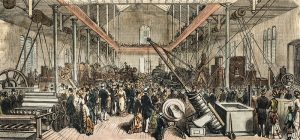
from sketches by Walter Goater.
Frank Leslie’s Illustrated Newspaper, Sept. 20, 1879, pg. 40.
The north and south wings of Music Hall were completed by the fall of 1879. They were built so exhibitors could set up industrial displays for the business community’s popular and financially beneficial expositions.
The north wing or hall – referred to as Power or Machinery Hall – featured mechanical devices and inventions.
During expositions, exhibits were also set up in the center building. These expositions were so huge that chairs were removed from Music Hall and, as the floor was flat in those days, exhibits were set up here too.
The south wing of Music Hall was Horticultural Hall. A glass roof provided a wonderful greenhouse effect, much like Krohn Conservatory today. It was one of the many wonderful permanent features in the facility.
A Lake in the South Wing of Music Hall!

Today the south wing holds the offices of the Cincinnati Symphony and Pops, and the May Festival. When it was first built, the floral displays in south hall included a rugged stone “hillside.” Water plunged down this huge rock wall and, according to newspaper reports,
…boiling up and over its sides broke away into a thousand streams and rivulets down the sides of the rugged pile, dancing and sparkling with untold beauty in the brilliant electric light, into the lake below.
A grotto was built among the rocks and featured a cavern for people to explore. Walks were laid out for visitors, and plant beds were set up for exhibits.
To accommodate the lake’s depth and the mechanics for the waterfall, the base was about three feet below the part used for exhibiting the plants.
The Seventh Industrial Exposition
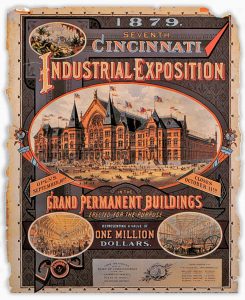
With these elements in place, the Seventh Industrial Exposition opened the morning of September 10, 1879.
Displays of cut flowers and floral arrangements were shown amid ornamental grasses, exotic palms and no less than 20 varieties of ferns, including tree ferns. New floral displays were featured every few days and premiums were awarded for the best new designs.
From the first day of the exposition, Horticultural Hall was the greatest attraction.
Even with all the pumps and hydraulic machinery in the north hall, furniture and choral performances in the main hall, and the excellent art display, the floral and horticultural exhibits were still the main draw for the exposition.
Oh, the hall was nature at its finest! Sunlight streamed through the window panes in the roof. The greenery created a place where people could stroll among the colorful and fragrant flowers, or relax and listen to the waterfall on the rocks. And, in the evening, colored lights were thrown upon the waterfall, making a beautiful display.
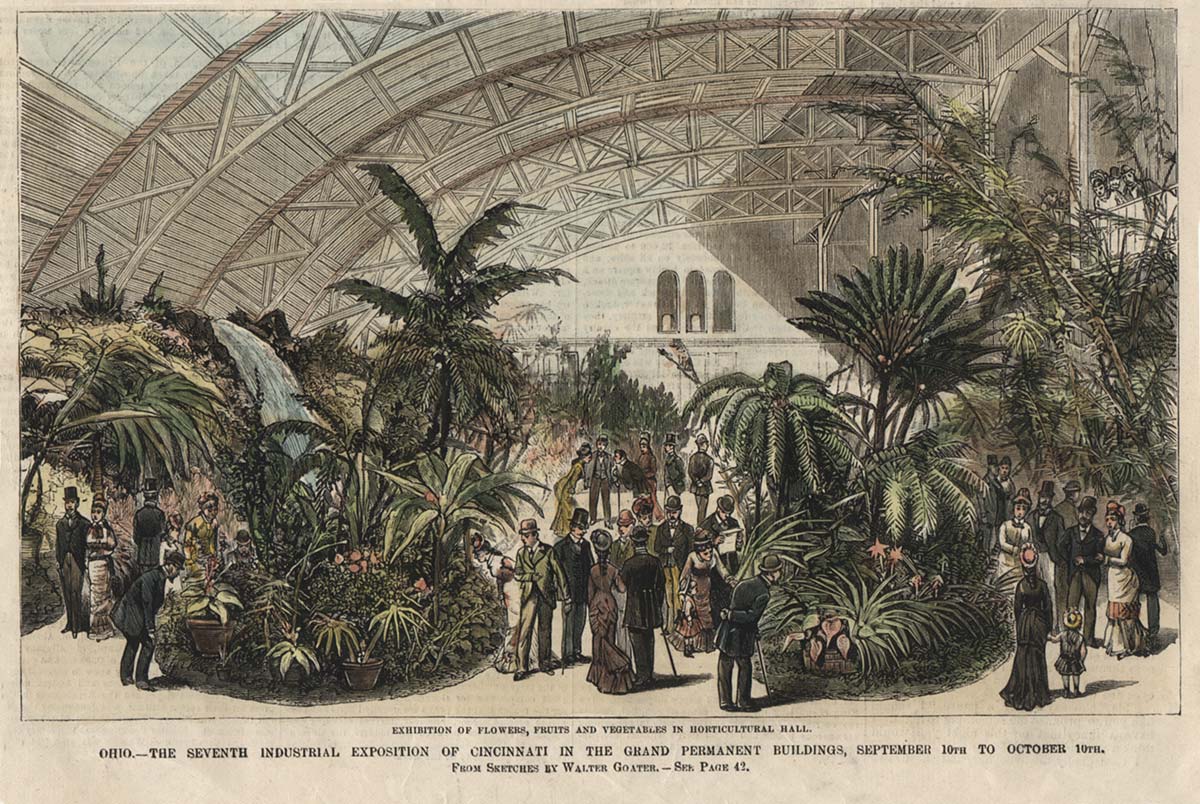
The Eighth Industrial Exposition
For the following year’s affair, the south wing was altered a bit, in response to the demands of both exhibitors and attendees.
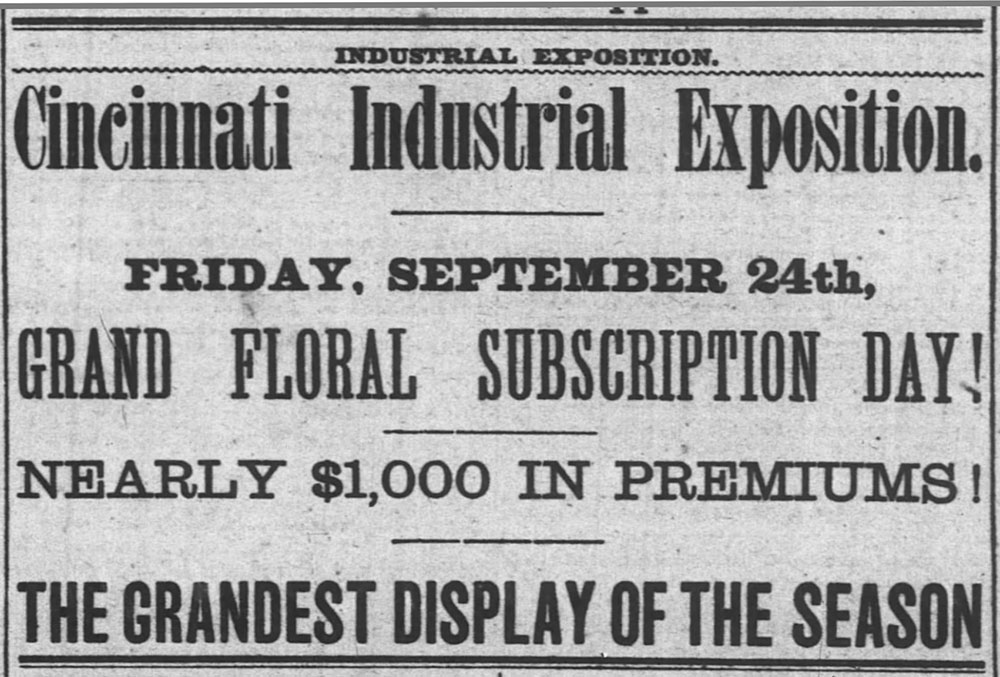
The lake was taking a lot of room that could be used for exhibits, so it was made smaller, and a little fish pond was added. The rockery was enlarged – mountainous even – and coated with crystals. More entrances to the cave were provided.
Exhibitors too upped the ante on their areas. Floral displays included a harp made of balsams, tuberoses, eupatorium and gladiolus – hundreds of different varieties of flowers, many blooming out of season. artistic varieties of colors and species ferns over 14 feet tall.
Adding to the dramatic effect of the waterfall was a young, two-foot-long alligator, on loan to the Exposition from the Zoological Garden.
It was amid the artistic designs of colors and species, and the lush, tall ferns, an alligator spent days lounging near the waterfall. Tens of thousands of people visited the exposition and most went through the horticultural exhibits. During his stay, the alligator was well behaved. He reportedly snacked on flies and bugs.
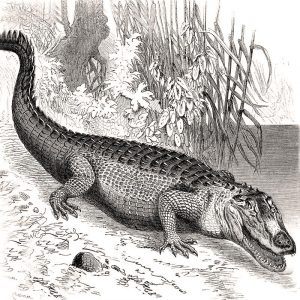
But then, one night, the alligator disappeared.
Did someone take it? After all, during that period in our history, many people looked at alligators as pets. There were stories in the papers about people bringing baby alligators from Florida. The New York Sun newspaper featured an article about a pet store selling them to fashionable ladies, who wanted them as pets.
As you can imagine, there were also reports about maturing alligators pulled out of the Little Miami, Licking and Ohio Rivers.
But what about the missing Music Hall alligator?
Well, it was thought perhaps it wandered off and died.
And then, it was forgotten.
For eighteen months.
How Did the Alligator Survive?
The south hall had all the makings of a great alligator escape: a waterfall and lake, multi-room cavern, and an elevated platform for floral displays. And in 1881 a pond and streams were added. This was all on dirt floors, which were common at that time.
Research shows alligators can survive 2-3 years without food. That could have been the case. Also, consider this: the canal was close by – right out the west doors of Music Hall. It was filthy and likely drew insects, rats and mice – not bad eating by ‘gator standards.
So, for all those months, the alligator was, well, a non-paying guest at Chez Music Hall.
The End of the Tale
The day after it was discovered, the alligator was removed and returned to the Cincinnati Zoo.
He had grown in those 18 months, and now measured 3 feet, half again as large as when he arrived.
A few weeks later, the Boston Post carried a brief mention of the encounter. The article speculated the workman fled the building with “the largest case of jim-jams* in town.”
*extreme nervousness or jitters

